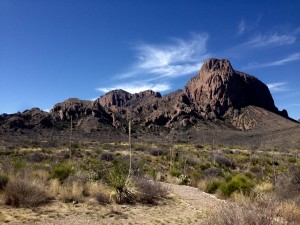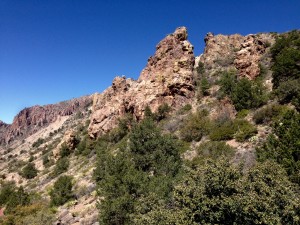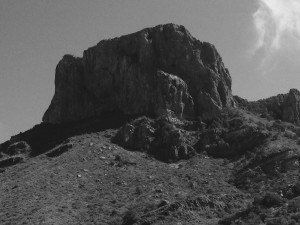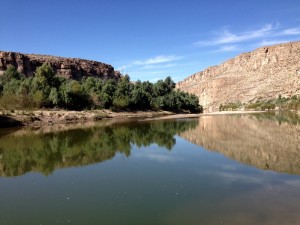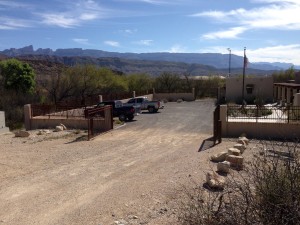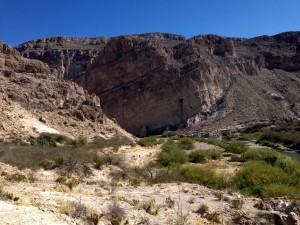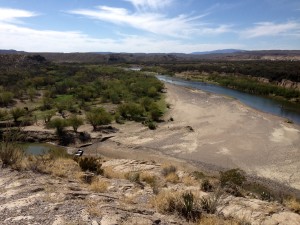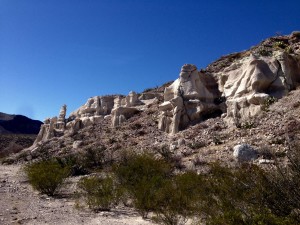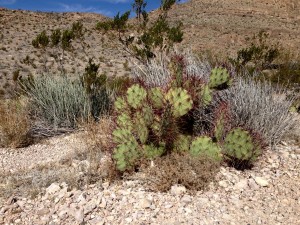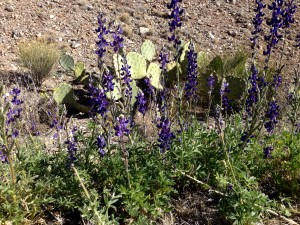As I approached the park from the north in the early morning, I was surprised by the silhouettes of the mountains that loomed ahead of me off in the distance. Not as high or as numerous as the Rockies in Colorado or Wyoming but every bit as rugged looking as any I’ve seen.
The Chisos Mountains are the only mountain range in the U.S. that is entirely contained in the boundaries of a park.
Big Bend has three distinct ecosystems; the desert, the mountains, and the river.
The entire southern boundary of the park is the Rio Grande River.
This is the Boquillas Crossing although you can’t actually cross here. You can just barely make out through the trees the town of Boquilles del Carmen, MX. Legend has it that this was a favored crossing for Pancho Villa because of the cover that the hills, canyons, and arroyos offered. The historic Ft. Davis, near where I’m camped, and the old military installation in Marfa, which incidently is now the grounds of The Chinati Foundation, are there because this was the main area where the U.S. Army prosecuted it’s “war” with Pancho Villa.
I was standing near the entrance to the Boquilles Canyon which was off to my left.
In this picture the river makes a hard right turn and passes right below. The trees, grassy ground and sand bar are Mexico. There were men fishing and grazing their horses. I could see people sitting under the trees. It caused me to think about people crossing even though I assumed the people I saw were family members of the men along the river. In the park and out, I traveled a long section of the river and saw lots of places where crossing would be easy. But the country is so rugged it would take a herculean effort to cross and penetrate deep into the US while avoiding the roadways which are full of park rangers, Texas Rangers, State Patrol, and Border Police. Without getting too political, I think that a lot of people who want a wall haven’t been down here. In my opinion a wall would be a speed bump compared to the hardship and risk of just making the trip. I ain’t sayin’, I’m just sayin’.
I’ve visited friends in Tucson and my sister and brother-in-law in Las Cruces, both cities in the desert southwest. In my experience it takes some time to get passed thinking of the desert as a bunch of rock, gravel, prickly things, and rattle snakes. It takes a practiced and accepting eye to finally begin to embrace the beauty that the desert contains. No doubt is takes some time and study to learn the timing and the conditions that make all of the desert plant species bloom when they do.
Having said all of that, I’m under no illusion that my little photographic offerings even begin to do justice to the beauty of the area I drove and hiked in today. By the way, in an earlier post I used the term beavertail cactus. I only used that because I didn’t really know what species they were and described them as I saw them. The leaves look like beavertails with spikes on them. I now know they are called prickly pear cactus and I feel suitably embarrassed that I didn’t know that, because they are one of the most common of all the cactus plants.
It was a long day on the road but well worth the trip. I don’t know if I’ll ever come this way again. I think that the best Big Bend has to offer is lots of remote and rugged hiking. i’m going to admit something that I think about a lot. I’ve spent my life going into the BWCA, several times by myself. Now I’m getting less and less inclined to put myself out there in the remote wilderness, particularly when I’m by myself.
I am well and hope you all are too.
